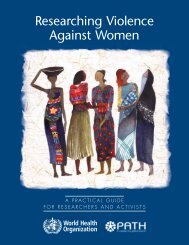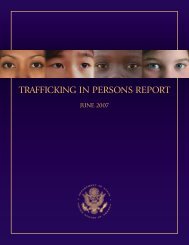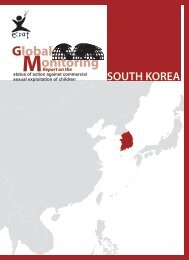Download PDF - Violence Against Children - East Asia and the ...
Download PDF - Violence Against Children - East Asia and the ...
Download PDF - Violence Against Children - East Asia and the ...
Create successful ePaper yourself
Turn your PDF publications into a flip-book with our unique Google optimized e-Paper software.
introduction<br />
Child as a normative framework to guide its<br />
programming <strong>and</strong> planning. This exacerbates<br />
<strong>the</strong> tendency to miss crucial CEDC (children<br />
in especially difficult circumstances) needs not<br />
only in normal urban <strong>and</strong> rural contexts, but<br />
also during economic crises.<br />
In World Vision’s repeated experience, <strong>the</strong><br />
risks faced by children rise dramatically<br />
during economic crises, with <strong>the</strong> labour,<br />
trafficking or sale of children becoming<br />
extreme coping mechanisms for families<br />
propelled into poverty. Sadly, <strong>the</strong> responses<br />
of <strong>the</strong> Bank at such times have been<br />
inadequate. The Bank’s myopia on children at<br />
risk is evident in relation to <strong>the</strong> Poverty<br />
Reduction Strategy 7 processes, for <strong>the</strong><br />
countries covered by this study <strong>and</strong> many<br />
o<strong>the</strong>rs. 8<br />
Initiatives are needed that respond to <strong>the</strong><br />
pressing priorities of children today <strong>and</strong> work<br />
to prevent <strong>the</strong> same factors causing harm to<br />
<strong>the</strong> children of tomorrow.<br />
In 2001, working on <strong>the</strong> basis of <strong>the</strong><br />
priority child protection issues identified in its<br />
2000 publication, UNICEF established its top<br />
five operational priorities for <strong>the</strong> <strong>Asia</strong>-Pacific<br />
region as:<br />
• children not in school<br />
• children who work for wages<br />
• children not living with biological family<br />
• access for birth registration of children, <strong>and</strong><br />
• action on reported cases of harm against<br />
children. 9<br />
UNICEF states that inclusion of children who<br />
are at risk or in need of special protection is<br />
a key principle in planning <strong>and</strong> operating<br />
government capacity-building projects for <strong>the</strong><br />
social sector. Approaches are needed that<br />
fur<strong>the</strong>r governmental action to promote child<br />
rights in practical ways through child-sensitive<br />
policing, law enforcement <strong>and</strong> social<br />
policy/practice reform. These specialist<br />
interventions need to be complemented with<br />
efforts to address root causes of child abuse<br />
<strong>and</strong> neglect. Approaches require<br />
mainstreaming of child protection measures<br />
to have broad impact. Community-based<br />
projects are able to reach more children than<br />
centre-based ones, <strong>and</strong> have greater<br />
opportunity for partnership. Prevention <strong>and</strong><br />
early intervention are needed in-community. 10<br />
The holistic approach to child protection <strong>and</strong><br />
development found in <strong>the</strong> CRC calls for<br />
integration <strong>and</strong> intention in <strong>the</strong> best interests<br />
of <strong>the</strong> child from governments. O<strong>the</strong>r actors<br />
that are key to this process are NGOs, civil<br />
society, <strong>the</strong> community, <strong>and</strong> children<br />
<strong>the</strong>mselves.<br />
The <strong>Children</strong> at Risk study<br />
Over an 18-month period in 2000–2001,<br />
World Vision undertook extensive research<br />
into <strong>the</strong> abuse <strong>and</strong> neglect of children in a<br />
number of <strong>the</strong> agency’s community<br />
development areas across three continents.<br />
This undertaking, in which World Vision<br />
partnered with representatives from <strong>the</strong><br />
Chapin Hall Centre for <strong>Children</strong> at <strong>the</strong><br />
University of Chicago <strong>and</strong> <strong>the</strong> International<br />
Society for <strong>the</strong> Prevention of Child Abuse <strong>and</strong><br />
Neglect (ISPCAN), resulted in a published<br />
report Crying Out: <strong>Children</strong> <strong>and</strong> communities<br />
speak on child abuse <strong>and</strong> neglect.<br />
Also known as <strong>the</strong> “child abuse <strong>and</strong><br />
neglect” (or “CAN”) study, 11 this research<br />
revealed that children were being abused in<br />
<strong>the</strong>ir families <strong>and</strong> communities to a significant<br />
extent. The report made recommendations,<br />
including <strong>the</strong> following, to streng<strong>the</strong>n<br />
provisions to protect children:<br />
• develop policy <strong>and</strong> programs that support<br />
families <strong>and</strong> build community<br />
• develop a conceptual framework of child <strong>and</strong><br />
youth participation<br />
• promote public awareness, advocacy <strong>and</strong><br />
coalition-building<br />
• build human capacity, <strong>and</strong><br />
• initiate outcome-focused research <strong>and</strong> evaluation.<br />
7<br />
National PRSPs are developed with Bank advice, assessed by Bank staff <strong>and</strong> approved by its Executive Directors.<br />
8 The Bank in December 2002 launched a new website area for "kids", offering a perspective on development intended for youth. Disappointingly, <strong>the</strong> site’s<br />
early content suggested that <strong>the</strong> Bank’s view of development, even when expressed directly to children <strong>and</strong> young people, included nei<strong>the</strong>r <strong>the</strong> issue of<br />
child rights, nor <strong>the</strong> reality of children at risk.<br />
9 Towards Monitoring Child Protection in <strong>East</strong> <strong>Asia</strong> <strong>and</strong> <strong>the</strong> Pacific, UNICEF, May 2001<br />
10 <strong>Children</strong> in Need of Special Protection in <strong>East</strong> <strong>Asia</strong> <strong>and</strong> <strong>the</strong> Pacific, UNICEF, 2000<br />
12<br />
11<br />
The "CAN study" referred to throughout this report is Crying Out: <strong>Children</strong> <strong>and</strong> communities speak on abuse <strong>and</strong> neglect, by Karl Dorning, published by<br />
World Vision International in 2002 as part of <strong>the</strong> World Vision campaign ‘Imagine a World Where <strong>Children</strong> are Safe’. Available on-line at<br />
http://www.wvi.org/imagine/can.htm

















